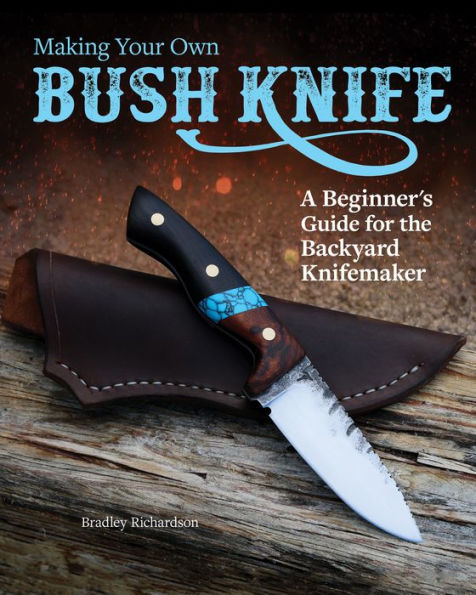
When making a cutting tool, I tend to think of a drill, endmill or other metalcutting tool being produced on a CNC tool and cutter grinder in a factory. A book by Bradley Richardson, however, describes how to make a different type of cutting tool with manual tools and equipment in a nonproduction environment. Published by Fox Chapel Publishing Co. Inc., Mount Joy, Pennsylvania, “Making Your Own Bush Knife: A Beginner’s Guide for the Backyard Knifemaker,” details the process of creating a custom knife, such as one for skinning game or basic woodcarving. Richardson, who resides in northern Michigan, sells his knives under the name Timberlee Tool & Trade and was a cast member on the History Channel’s “Alone” survival show.
The 184-page book covers each step required for a bladesmith to make a bush knife, including selecting the steel, creating a profile, forging the blade or profiling by stock removal, grinding the bevels, and attaching and shaping the handle. Throughout the photo-packed guide, Richardson emphasizes the importance of personal safety in a knife shop, as well as knife safety. The book also examines the tools of the trade, with a focus on acquiring them economically or building them from scratch, which the author did for two belt grinders.
“I’m a firm believer that the best tool for the job is one that you can find in the garage,” he wrote.
When made and maintained properly, a hand-crafted bush knife is a custom work of art that can last for generations. Similar to the metal sculptors by Chris Bathgate that I wrote about in the March 2019 issue, production efficiency is not the goal when crafting a knife. The process requires a great deal of time and patience and the ability to learn from every mistake that’s made. And based on the photo of Richardson’s “knife graveyard” box, mistakes are common.
The most challenging element of successful knife making seems to be heat treating the blade to achieve an ideal balance of toughness and hardness without having a furnace or oven that’s specifically designed for the task. As Richardson stated, “Practice makes perfect, and perfect is rare. If there is one thing I could go back and do as a beginner, it would be to spend more time learning tempering and the art of metallurgy.”
According to Richardson, for those willing to dedicate the time and effort to do it right, making knives can become a meditative craft. Even if it involves hammering a hot piece of steel for hours on end to forge a blade to shape. Personally, I’d go with the alternative to working hot steel and profile by stock removal.
Related Glossary Terms
- computer numerical control ( CNC)
computer numerical control ( CNC)
Microprocessor-based controller dedicated to a machine tool that permits the creation or modification of parts. Programmed numerical control activates the machine’s servos and spindle drives and controls the various machining operations. See DNC, direct numerical control; NC, numerical control.
- endmill
endmill
Milling cutter held by its shank that cuts on its periphery and, if so configured, on its free end. Takes a variety of shapes (single- and double-end, roughing, ballnose and cup-end) and sizes (stub, medium, long and extra-long). Also comes with differing numbers of flutes.
- grinding
grinding
Machining operation in which material is removed from the workpiece by a powered abrasive wheel, stone, belt, paste, sheet, compound, slurry, etc. Takes various forms: surface grinding (creates flat and/or squared surfaces); cylindrical grinding (for external cylindrical and tapered shapes, fillets, undercuts, etc.); centerless grinding; chamfering; thread and form grinding; tool and cutter grinding; offhand grinding; lapping and polishing (grinding with extremely fine grits to create ultrasmooth surfaces); honing; and disc grinding.
- hardness
hardness
Hardness is a measure of the resistance of a material to surface indentation or abrasion. There is no absolute scale for hardness. In order to express hardness quantitatively, each type of test has its own scale, which defines hardness. Indentation hardness obtained through static methods is measured by Brinell, Rockwell, Vickers and Knoop tests. Hardness without indentation is measured by a dynamic method, known as the Scleroscope test.
- metalcutting ( material cutting)
metalcutting ( material cutting)
Any machining process used to part metal or other material or give a workpiece a new configuration. Conventionally applies to machining operations in which a cutting tool mechanically removes material in the form of chips; applies to any process in which metal or material is removed to create new shapes. See metalforming.
- profiling
profiling
Machining vertical edges of workpieces having irregular contours; normally performed with an endmill in a vertical spindle on a milling machine or with a profiler, following a pattern. See mill, milling machine.
- shaping
shaping
Using a shaper primarily to produce flat surfaces in horizontal, vertical or angular planes. It can also include the machining of curved surfaces, helixes, serrations and special work involving odd and irregular shapes. Often used for prototype or short-run manufacturing to eliminate the need for expensive special tooling or processes.
- tempering
tempering
1. In heat-treatment, reheating hardened steel or hardened cast iron to a given temperature below the eutectoid temperature to decrease hardness and increase toughness. The process also is sometimes applied to normalized steel. 2. In nonferrous alloys and in some ferrous alloys (steels that cannot be hardened by heat-treatment), the hardness and strength produced by mechanical or thermal treatment, or both, and characterized by a certain structure, mechanical properties or reduction in area during cold working.

